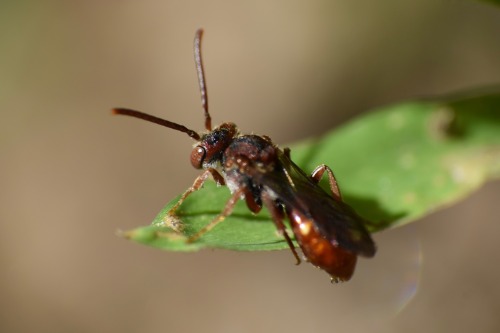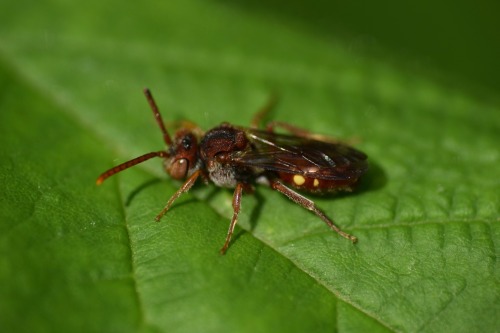Brave Squirrel...
Brave Squirrel...
More Posts from Northerlyy and Others




Nomad Bees (Genus Nomada), taken May 5, 2025, in Georgia, US
Some little red bees! These guys are always super busy unless, of course, they're sleeping like in the third image! Yesterday the bees were quite gracious with their landing times, sitting still long enough for me to actually press the shutter button lol. Normally, they're flying around constantly, searching for the burrows of other bees to lay their eggs in!
I've gotten some decent quality pics of cuckoo wasps with my clip-on macro lens, but I've never had the opportunity to try with my actual camera, so I have no idea if I'd have the same issue as you guys lol. I both love tiny bugs because they're usually surprisingly beautiful but also hate them because they're so small you need an $800 lens to get good pictures of them...
Here is the cuckoo I've gotten w/ my clip-on lens. They're honestly way darker green up close—it must be how the sun hits them!


i am photographing hymenopterans that are smaller and more indistinguishable than you could possibly imagine

Two-lined Leatherwing (Atalantycha bilineata), taken April 2, 2025, in Georgia, US
Look at the size difference between them! By far not the largest I've ever seen, but the male is still only about 1/3 of the female's size! A size difference about this large is pretty typical for soldier beetles, though many other kinds of beetles have little to no size difference at all. For all of the individuals of this species I've been seeing around (hundreds), this is the first time I've seen a mating pair!



Lesser Anglewings (Microcentrum retinerve), nymphs, taken May 2, 2025, in Georgia, US
Katydids in their awkward baby phase! Their legs are so spindly and long as young nymphs, kind of like a horse foal. Even though their limbs are a bit too long, they are still very nimble and navigate the tall grasses with ease. Alongside these guys, I'm also seeing lots of meadow katydid nymphs which will eventually become short-winged and handsome meadow katydids, though it's impossible to tell which at their current age!


Rough Stink Bugs (Brochymena arborea), taken September 17, 2024, in Georgia, US
My favorite stink bug friends to see around!! There's honestly nothing about them that really stands out, but they have neat spiny protrusions on their shoulders that can be used to ID the species and cool camouflage for life on trees! Occasionally I'll see a fresher adult that's almost completely black and white instead of brown, which looks pretty neat!
100% agree lol. I've gotten better over the years, but my astraphobia combined with liking to look at bugs and southeast tornado shenanigans makes storms suck a lot.
You're right that the best part of a storm is directly after when the sun has just started to come back out! A lot of insects that are usually flying out of reach are grounded from the weather and easy to photograph, and some that prefer wet weather are more common after rain. I remember going out the day after hurricane Helene hit last year and finding a ton of bugs I'd never seen before because everything was out of sorts from the unusual weather. It was a nice reward for weathering the storm!
It sucks that I can't enjoy thunderstorms that much comparatively to a lot of other people, but as someone who currently lives in a tornado zone and whose hobbies include going outside and walking around looking for bugs, the thing I like most about rain is the immediate aftermath—otherwise it's just, like, a loud, stressful inconvenience to me, sadly

Handsome Meadow Katydid (Orchelimum pulchellum), female, taken September 28, 2024, in Georgia, US
Handsome, indeed! I have dozens of pictures of these guys, not just because they exist in excess here, but also because they're just too beautiful for me to pass up photographing! This species is differentiable from all others in the genus at almost every life stage by its bright blue eyes, which nobody else shares. It's quite striking to see a katydid with a rainbow of colors, even after having seen them a hundred times!

Mourning Dove (Zenaida macroura), taken June 28, 2024, in Georgia, US
Pondering, I believe. Sometimes life is just sitting on the edge of the bird bath and overlooking the koi pond a few feet ahead.


Brown-headed Cowbird (Molothrus ater), juvenile, being fed by a Song Sparrow (Melospiza melodia), taken May 9, 2025, in Georgia, US
A fat cowbird chick being fed by its song sparrow foster parent! It seems as though our only song sparrow pair were chosen by the cowbirds as fosters this spring. Luckily, song sparrows are known to attempt to nest up to four times in a season, so they have plenty of chances left to raise their own brood! Once this baby cowbird becomes independent, it will meet with other baby cowbirds and begin its life as a young adult! For now, though, it's content to take handouts from mom and dad!
I feel as though the concept is much more common knowledge now, but to those who come across this and don't know: cowbirds are nest parasites, meaning they lay their eggs in the nests of other birds so they don't have to raise their babies themselves. They do this because building a nest and caring for young is extremely costly for females and may result in a lower chick yield than creating more eggs (up to 40) and laying them in an array of host nests does. The cowbird chick often hatches before the host nest's chicks, grows faster, becomes larger, and is louder, leading to the host chicks being neglected and often dying before fledging. While this is sad, bird parents have evolved to account for the possibility of being parasitized and will often nest multiple times in a season to ensure they have at least one healthy brood of their own chicks! Many bird species are also extremely good at recognizing cowbird eggs and can either eject them from the nest or destroy them before they hatch. Nest parasites are one of many natural population control agents that ensure native bird populations remain stable, so they are not a bad thing if the parasite is native, which cowbirds are in the US!



Carolina Chickadee (Poecile carolinensis), taken March 11, 2025, in Georgia, US
A small friend enjoying an equally small seed. The buds on the japanese maple make pictures in it look much more lively! Once it has leaves, the birds will be much harder to find within the sea of red. For now, however, I get to enjoy them in plain sight!
-
 sissylissy1900 liked this · 4 weeks ago
sissylissy1900 liked this · 4 weeks ago -
 absentminded-potato liked this · 4 weeks ago
absentminded-potato liked this · 4 weeks ago -
 vkngfrnz9 liked this · 4 weeks ago
vkngfrnz9 liked this · 4 weeks ago -
 lazy-but-amazing liked this · 4 weeks ago
lazy-but-amazing liked this · 4 weeks ago -
 rbrown4321 reblogged this · 4 weeks ago
rbrown4321 reblogged this · 4 weeks ago -
 a1-1976 liked this · 4 weeks ago
a1-1976 liked this · 4 weeks ago -
 333mrdaddy reblogged this · 4 weeks ago
333mrdaddy reblogged this · 4 weeks ago -
 adelth liked this · 4 weeks ago
adelth liked this · 4 weeks ago -
 natureandscience47916 reblogged this · 4 weeks ago
natureandscience47916 reblogged this · 4 weeks ago -
 kimmingtonjames liked this · 4 weeks ago
kimmingtonjames liked this · 4 weeks ago -
 thefunkybassist liked this · 4 weeks ago
thefunkybassist liked this · 4 weeks ago -
 psychicponyroadbakery liked this · 4 weeks ago
psychicponyroadbakery liked this · 4 weeks ago -
 meninaseria liked this · 4 weeks ago
meninaseria liked this · 4 weeks ago -
 madebycassandra liked this · 4 weeks ago
madebycassandra liked this · 4 weeks ago -
 petedapuma liked this · 4 weeks ago
petedapuma liked this · 4 weeks ago -
 titidiaper liked this · 4 weeks ago
titidiaper liked this · 4 weeks ago -
 stemlover71 liked this · 4 weeks ago
stemlover71 liked this · 4 weeks ago -
 evenlopz liked this · 4 weeks ago
evenlopz liked this · 4 weeks ago -
 canaron liked this · 4 weeks ago
canaron liked this · 4 weeks ago -
 jjtherscuck liked this · 4 weeks ago
jjtherscuck liked this · 4 weeks ago -
 articu-lista liked this · 4 weeks ago
articu-lista liked this · 4 weeks ago -
 ilikepornsohereigo liked this · 4 weeks ago
ilikepornsohereigo liked this · 4 weeks ago -
 whydoihavetopickaname liked this · 4 weeks ago
whydoihavetopickaname liked this · 4 weeks ago -
 james-smhan-blog reblogged this · 4 weeks ago
james-smhan-blog reblogged this · 4 weeks ago -
 james-smhan-blog liked this · 4 weeks ago
james-smhan-blog liked this · 4 weeks ago -
 fatripspiercednips liked this · 4 weeks ago
fatripspiercednips liked this · 4 weeks ago -
 fulcrum-art-fox liked this · 4 weeks ago
fulcrum-art-fox liked this · 4 weeks ago -
 craters-and-fire liked this · 4 weeks ago
craters-and-fire liked this · 4 weeks ago -
 daretoshowit2 liked this · 4 weeks ago
daretoshowit2 liked this · 4 weeks ago -
 lordielord4257 liked this · 4 weeks ago
lordielord4257 liked this · 4 weeks ago -
 letsseewherewegetto liked this · 4 weeks ago
letsseewherewegetto liked this · 4 weeks ago -
 letsseewherewegetto reblogged this · 4 weeks ago
letsseewherewegetto reblogged this · 4 weeks ago -
 momento-mig liked this · 4 weeks ago
momento-mig liked this · 4 weeks ago -
 712220 liked this · 4 weeks ago
712220 liked this · 4 weeks ago -
 jrstakes1808 reblogged this · 4 weeks ago
jrstakes1808 reblogged this · 4 weeks ago -
 jrstakes1808 liked this · 4 weeks ago
jrstakes1808 liked this · 4 weeks ago -
 konfucyi liked this · 4 weeks ago
konfucyi liked this · 4 weeks ago -
 gettinitin84 liked this · 4 weeks ago
gettinitin84 liked this · 4 weeks ago -
 carabossse liked this · 4 weeks ago
carabossse liked this · 4 weeks ago -
 0987654321aa liked this · 4 weeks ago
0987654321aa liked this · 4 weeks ago -
 roadwarrioroverland reblogged this · 4 weeks ago
roadwarrioroverland reblogged this · 4 weeks ago -
 roadwarrioroverland liked this · 4 weeks ago
roadwarrioroverland liked this · 4 weeks ago -
 jabbasyogainstructor reblogged this · 4 weeks ago
jabbasyogainstructor reblogged this · 4 weeks ago -
 just-me-in-panties liked this · 4 weeks ago
just-me-in-panties liked this · 4 weeks ago -
 ojvi liked this · 4 weeks ago
ojvi liked this · 4 weeks ago -
 narihira8 liked this · 4 weeks ago
narihira8 liked this · 4 weeks ago -
 zealousperfectioncollection-3467 liked this · 1 month ago
zealousperfectioncollection-3467 liked this · 1 month ago -
 fogandfireflies liked this · 1 month ago
fogandfireflies liked this · 1 month ago -
 curiosforlife liked this · 1 month ago
curiosforlife liked this · 1 month ago

Wildlife photography of all kinds in no particular chronological order... call me North!All photos posted are taken by me, and everything that appears here is documented on iNaturalist as well.
242 posts